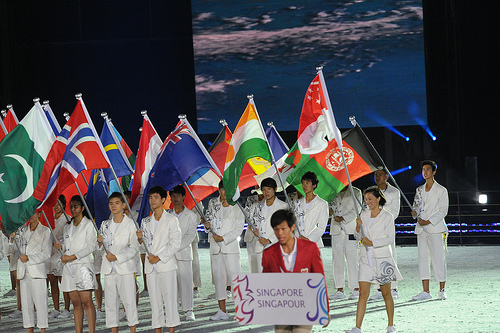 Friday night’s upcoming opening ceremonies mark the official start of the 2012 London Olympic Games. As each participating country is presented during the Parade of Nations, led by a representative with their nation’s flag, we here at MLJ Adoptions thought we’d take a look at the meaning behind some of our program countries’ flags.
Friday night’s upcoming opening ceremonies mark the official start of the 2012 London Olympic Games. As each participating country is presented during the Parade of Nations, led by a representative with their nation’s flag, we here at MLJ Adoptions thought we’d take a look at the meaning behind some of our program countries’ flags.
John Thune, an American politician, recognized that a “flag is more than just cloth and ink. It is a universally recognized symbol that stands for liberty, and freedom. It is the history of [a] nation, and it’s marked by the blood of those who died defending it.” Every country’s flag are full of symbols that give insight into a country’s history and role in the world.
From colors, images, to spacing on a flag everything holds significance. For example, in the seemingly simple Bulgarian flag, which consists of three horizontal stripes, each of the three colors means something. White symbolizes peace and honesty, while green represents hope, joy, love, and finally red stands for hardiness bravery, strength, and valor. To those of us who aren’t Bulgarian we just see three simple stripes, but to a citizen of Bulgaria they see all of these qualities and they see what their country should be to them. To them the country strives to be peaceful, honest, loving, and full of joy; however, if war should come upon the nation they are brave, strong, and possess valor.
However, not all flags are composed solely of colors. The Honduran flag has three horizontal stripes but in the middle of the flag is five-pointed stars made into an “X” shape with each star representing one of the members of the former Federal Republic of Central America. While its colors of white and blue mean peace, honesty, vigilance, truth, loyalty, perseverance, and justice. If you notice, many flags have white on them because having a country that strives to be peaceful and honest is something that inspires pride in many citizens.
Countries also have the ability to change their flag based on a change in the way a country wants to be seen in the eyes of its citizen. For example, the most recent flag of the Democratic Republic of the Congo was adopted in February of 2006. The new flag transitioned from a royal blue to a sky blue, which represents peace and it is said that the red on the flag is for “the blood of the country’s martyrs, [the] yellow [is] the country’s wealth, and the star [is] a radiant future for the country.”
Flags can symbolize not only a country’s role, but also their history, and sometimes even geographic location. The Nicaraguan flag is one that possesses all of these. All of the colors on the flag were originally found on the flag of the United Provinces of Central America, of which Nicaragua used to be a part of. The two blue stripes on the flag symbolize the Pacific Ocean and the Caribbean Sea, while the white in the middle stands once again for peace. Then in the center of the flag is the Nicaraguan coat of arms which consists of symbols that represent equality, liberty, peace, and even the five members of the former United Provinces of Central America.
Similarly, the Samoan flag illustrates the geographical location of the country as well as its links to other countries throughout its history. The majority of the flag is red to symbolize courage, but the blue and white on it represent freedom and purity or peace. The five white stars are meant to be the constellation the Southern Cross, a well-known constellation in the Southern hemisphere. The Southern Cross represents the geographical location of the country and its ties to New Zealand, which also has the Southern Cross on its flag.
Ukraine’s flag of blue and yellow horizontal stripes not only symbolize straits but also the landscape of the country. Blue here symbolizes peace and the sky and water in Ukraine, while the yellow stands for prosperity and the wheat fields in the country.
Each country’s flag has a meaning behind it and with the Olympic Games upon us it’s important to not only know what are flag means to us but also to understand how much flags all over the world mean to their citizens. Remember that no flag is ever just a piece of cloth, it is the past, present, and future of a country.
The Opening Ceremonies and flag history provides perfect backdrop for parents to learn more about their child’s home country and is a great conversation starter.
Photo Credit: Ng Chee Keong
For more information about MLJ Adoptions’ international adoption programs, please click here.
